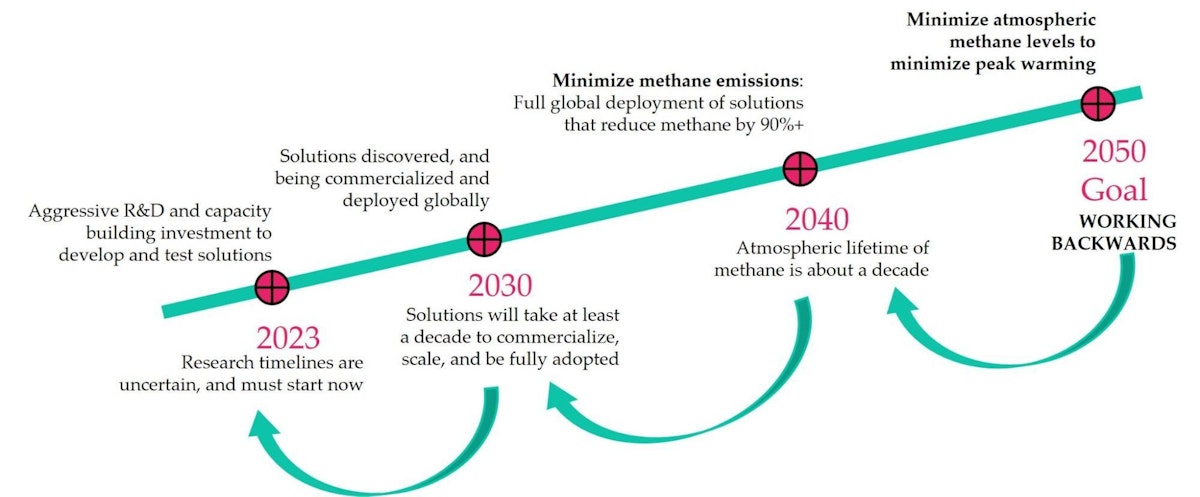We Can’t Manage Cattle Methane Without Better Measurements
Addressing enteric methane emissions requires more research and researchers

-
-
Share
-
Share via Twitter -
Share via Facebook -
Share via Email
-
National governments increasingly aim to cut methane emissions from energy, agriculture, and waste. Under U.S. President Joe Biden, the United States became one of 150 countries to have signed the Global Methane Pledge, which means the administration agreed to be a part of a global effort to reduce methane emissions by at least 30% below 2020 levels by 2030. Since methane has a large, but short-term effect on global warming, reducing methane emissions can substantially reduce warming in the coming decades.
One priority is reducing emissions from enteric fermentation, part of the digestive process of cattle, sheep, and other ruminants. In the United States, enteric fermentation has accounted for about 25% of all methane emissions over the last ten years. And, with rising global demand for beef—driven largely by population growth and increasing wealth—enteric methane emissions are projected to rise by more than 45% between 2020 and 2050.
Companies throughout the livestock supply chain—dairy suppliers like Danone, supermarkets, fast food chains, and others—are now increasingly seeking to cut their methane footprint.
Minimizing Peak Warming Requires Methane Reducing Research Today

Yet as management guru Peter Drucker famously said, “If you can’t measure it, you can’t manage it.” Such is the case with enteric methane.
The technology to accurately estimate emissions at scale—across a dairy or beef company’s supply chain, for instance—generally does not yet exist. In 2020, Burger King notably had to walk back its claims of producing low-methane beef when scientists pointed to the lack of supporting evidence. Since then, other companies such as TruBeef and Silver Fern Farms have claimed to produce carbon-neutral beef. But many researchers and industry actors agree that a lack of verifiable on-farm emissions data undermines such claims, complicates supply chain carbon accounting, and generally obstructs mitigation efforts.
To better assess progress toward methane mitigation targets—let alone achieve them—researchers must accomplish at least three things. First, they must make measurement of livestock emissions more accurate, consistent, and affordable. This is critical for assessing the effectiveness of changes in livestock management in reducing emissions, and for estimating emissions embodied in supply chains or particular products. Second, researchers must use measurement data to develop predictive models (for example, carbon footprint calculators) of different practices before those practices are implemented and to inexpensively estimate emissions without on-farm measurement. Third, scientists must measure and test methane reduction strategies in a greater range of environments than has been done thus far, particularly with animals while they’re grazing, which is when they appear to emit the most enteric methane. Governments and the private sector can each contribute to these goals by investing in enteric methane research.
Make enteric methane measurement and modeling affordable and accurate
Presently, there are several approaches to directly measure enteric methane emissions: respiratory chambers, the SF6 tracer technique, GreenFeed systems, and micrometeorological measurements.
Respiratory chambers are generally considered the gold standard for directly measuring individual animal emissions. These are built as enclosures for animals where air at the inlet and outlet is measured for methane and other greenhouse gases.
While highly accurate, chambers cannot be used to assess emissions from grazing animals, especially under normal behavior. That requires attaching canisters to animals to capture their respiration and belches, and using the SF6 tracer technique to estimate emissions.
Another, newer approach is to use a GreenFeed System, which directly measures snapshots (3-6 minutes) of enteric methane production in the breath of ruminants in pastures or feedlots while they are eating. These measurements are then used to estimate daily emissions.
A fourth approach, applicable when animals are grazing, uses ~10m tall towers with tubing that draws air into methane sensors as air circulates in the atmosphere. These tower-based approaches are referred to as micrometeorological measurement techniques. Given their setup, micrometeorological towers measure the net amount of methane emitted from an area of land, capturing not only enteric emissions but also emissions from manure and soils—measuring the whole system.
Some such approaches have benefits for individual animal feeding trials of feed additives, yet none are easily deployable on farms—for now—a missing step for accurate supply chain carbon accounting.

Several indirect measurement methods also help reduce the cost of estimating emissions. In vitro flow systems mimic what happens in an animal’s rumen, the part of the stomach where bacteria turn food into methane and other compounds. They are a lab-based approach to measuring the effect of different feeds, drugs, and other products on methane emissions. They are important for screening new products at a low cost to help determine whether a more expensive animal feeding trial is warranted. Researchers are also developing methods to use proxies, such as blood samples, to estimate emissions.
Increasingly airborne measurements—like drones—are also being used to estimate methane emissions over large areas, although are not yet commercially available. In addition, high resolution satellite-based measurements are expected to come online soon. These higher resolution satellites should be able to quantify emissions from some large concentrated animal sources like commercial dairies.

However, there are at least two big shortcomings with measurement today. First, there are not enough universities and other institutions with measurement equipment to meet demand. Only a handful of land-grant universities have access to the gold standard in methane emissions measurement technology for individual animals: respiratory chambers. Likewise, according to conversations with experts in the industry, only 18 colleges or universities across the US have the newer ‘snapshot’ measurement system, the GreenFeed System. Within USDA’s internal research arm, the Agricultural Research Service (ARS), only six stations have GreenFeed Systems. Fewer still have the ability to compare GreenFeed and respiratory chamber methods against each other when studying diets and feed additives—a recognized standard operating procedure. Meanwhile, demand for testing of methane-reducing products is growing. This mismatch between supply and demand for methane measurement poses a large bottleneck in advancing knowledge and commercialization of potential enteric methane mitigation options.
Second, existing measurement technologies are too expensive, labor intensive, and/or technical for livestock producers to purchase and operate. They are typically only used in research settings. While the GreenFeed system is perhaps the easiest method for commercial producers to use, it is still cost-prohibitive outside of research institutions (~$90,000 for the device with another ~$10,000 annually for data acquisition) and requires at least several days of work to train cattle to use the system. Additionally, the most common land measurement approaches require extensive technical knowledge to calibrate and maintain sensors or to run gas chromatographs. Aerial and satellite-based measurement can address some of these issues, but is also highly expensive, unable to measure methane from individual animals or groups, and currently not precise enough to measure emissions from most animal agriculture operations such as pastures.
Overcoming these two limitations—institutional and technological—would enable greater progress in several types of enteric methane research. First, universities and companies would be able to produce a sufficient number of studies and replications to improve the certainty of efficacy claims about the methane reduction potential of feed additives in the near term. Second, it would facilitate trials that can assess long-term efficacy and animal safety. Third, it would accelerate efforts to breed low-methane cattle, whether using conventional or novel techniques such as gene editing.
Greater measurement would also enable development of more accurate predictive models. Since direct measurement will always carry a cost, at least some livestock producers and other companies in the supply chain will likely need to rely on models (for example, carbon footprint calculators) to estimate emissions. Investments in developing and refining both bottom-up diet-based methane predictive models and top-down climate models may be as important to mitigation as investment in better measurement technologies. Ideally, these models could be used to accurately estimate emissions under a wide range of scenarios, such as when producers adopt a new feed additive. Predictive models do exist, but they haven’t been designed to assess the impact of many interventions to reduce emissions. To build these models, researchers must first gather emissions data from a variety of diets, breeds, and management conditions. The more robust those data are, the more reliable the model will become. Eventually, models will eliminate the need for every animal to be sampled.
Conduct more regionally specific field trials
To understand the efficacy of different livestock management practices in reducing methane emissions, researchers need to conduct trials in diverse locations and across operation types. Studies have shown that the feed additive 3-NOP can decrease methane production between 30% and 70%. However, the efficacy depends on diet, among other factors. In particular, 3-NOP’s efficacy diminishes as the amount of cellulose in the diet increases. This is problematic given that ~77% of methane emissions from beef production result from cattle grazing on cellulosic material in pastures.
The few global scholars doing this work also recognize that more animal feeding trials are needed to determine methane reductions from feeding Asparagopsis taxiformis—or red algae. Supplementing ruminants’ diets with A. taxiformis resulted in 9–98% reduction in methane production across studies. Such a range complicates efficacy claims—it must be narrowed through more research. And, much like 3-NOP, some research suggests supplementation is more effective in high-starch diets (for example, at feedlots) compared to high-forage diets (for example, range and pasture). Precise estimates of efficacy therefore require running trials with different types of feed and in different types of rangeland and pasture.
Additionally, pre-existing microbial communities in the rumen are very resilient. A single dosing of either 3-NOP or A. taxiformis can reduce enteric methane briefly, but emissions return when it is no longer actively being fed. Thus, current delivery methods of feed additives incorporated into the daily diets of conventionally managed dairy cows and feedlot finished beef cattle work well. However, more appropriate and adaptable delivery methods need to be developed and tested if these products are to be incorporated in less intensively managed grazing production systems across the country.
Federal research can drive enteric methane innovation

Accurate enteric methane emissions data are at the core of reducing methane emissions from global livestock, and substantially reducing warming in the coming decades. Federal, state, and other governments can improve measurement and data collection by funding enteric methane research and data collection. Data, in turn, can be used to inform decisions about what actions to take to address climate change, for example, which diets and management practices to support. The scientific community estimates that adequately addressing the research needs for methane-reducing feed additives alone will require a $100 million investment in multi-year trials.
Congress, USDA, and other policymakers have several tools at their disposal to advance measurement, modeling, and ultimately mitigation of enteric methane emissions. These options include intramural research, extramural research, and public-private partnerships.
USDA’s Agricultural Research Service (ARS) conducts intramural research, including on livestock sustainability, at its sites around the country. Some notable sites that have done work on carbon and nitrogen cycling in livestock include the ones in Kimberly, ID and Bushland, TX. Investment in updating ARS facilities will allow for regionally specific diets and breeds to be accounted for in data collection. More ARS sites should be equipped with state-of-the-art methane measurement instruments to ensure standardization in data collection and output. ARS sites are well-suited to quickly address many research gaps since they often have low barriers to launch new projects compared to universities.
Structure of U.S. Public Agricultural R&D

USDA also hosts the flagship extramural research funding initiative, the Agriculture and Food Research Initiative (AFRI), which can and does fund enteric research. For example, within the Foundational and Applied Sciences request for application, enteric methane is highlighted as important in the Animal Nutrition, Growth, and Lactation program area. Additionally, at least five other program areas in that request solicit proposals to address greenhouse gas emissions from agriculture. Recently, AFRI devoted up to $5 million in funding under its Sustainable Agriculture Systems program to enteric methane research, as part of a broader international effort to accelerate enteric innovation. These funding opportunities are steps in the right direction. Still, between 2017 and 2021, projects to understand, measure, and reduce enteric methane emissions accounted for less than 2% of non-ARS funding for agricultural climate mitigation. Thus, despite the potential opportunities to fund enteric methane research through extramural grants, barriers to advancements exist, one of which may be the highly competitive nature of these grant programs. About 70% of AFRI proposals that are deemed worthy by expert review panels are not funded.
Other funding mechanisms exist. Through a Congressional mandate, Foundation for Food and Agriculture Research (FFAR) is funded to deliver public-private partnership-type research grants. The Greener Cattle Initiative, housed within FFAR, is an industry-oriented research consortium that will award approximately $5 million over the next five years to support research to mitigate enteric methane emissions from cattle. Together with the new sustainable agriculture systems request, these efforts will distribute $10 million over the next five years. While the $10 million directed toward enteric methane research is certainly needed, it comes far short of the $100 million needed to adequately address the issue.
Meeting the scientific capacity is also contingent upon continued expertise. Unfortunately, methane-related livestock expertise dwindles with increased retirements. To reduce any gaps in knowledge, the next generation of scientists need funding to be trained under current experts. One avenue to address the shrinking pool of methane-related talent is the AFRI Education and Workforce Development program which funds research experiences for undergraduates, predoctoral fellowships, and postdoctoral fellowships. Additionally, FFAR provides scholarships to help veterinary students perform research in areas like climate change.
Scientific and Human Capacity Needs for Addressing Enteric Methane

Ultimately, enteric methane research and innovation is an important part of minimizing emissions and peak warming. While some federal programs and grants do fund relevant research, the amount of funding is far below what researchers say is needed. Recognizing the gaps in methane emissions measurement and research capacity, researchers, industry, and companies must work collaboratively to build scientific expertise, improve measurement technology, develop mitigation options, create robust models, and increase adoption of emerging technologies. Only then can farmers, processors, retailers, and others throughout the supply chain account for and verify emissions, and work effectively to rapidly reduce their carbon footprint.

